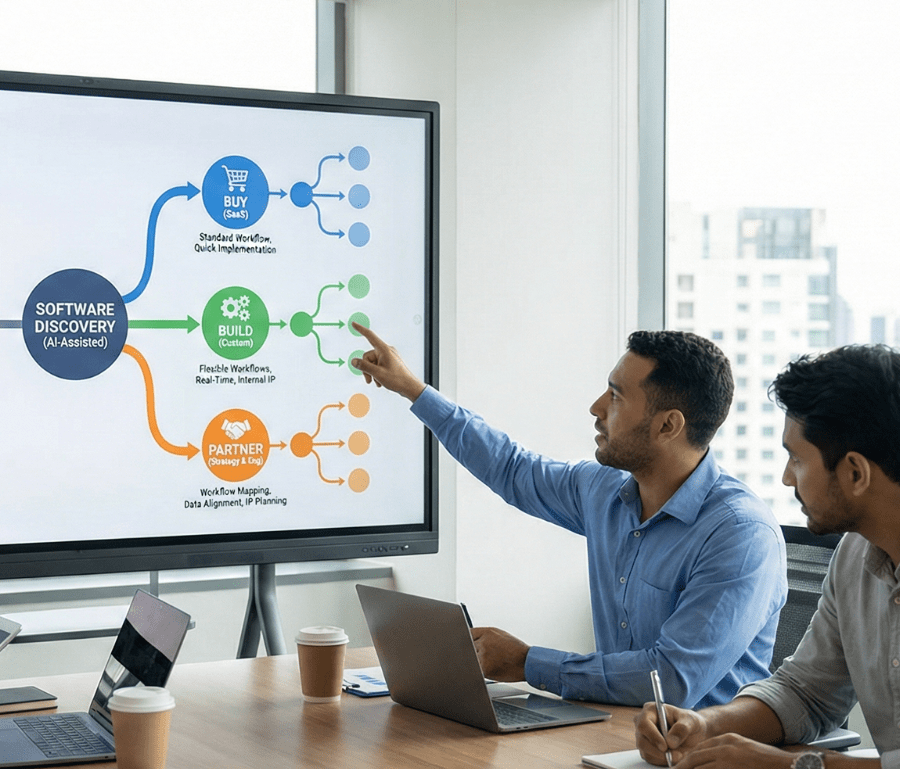Hi Bob. Can you tell us about Digital Scientists and your company’s mission?
Sure. I’d love to. Digital Scientists is an experience lab. We design and develop software products and digital platforms that focus on improving the human experience with AI. Through our expertise in AI, UX design, and mobile app development, we help clients reinvent existing experiences or build new experiences, always with an eye on speed-to-market.
Tell us a bit about your background and how you started the company.
My identical twin brother and I started the company back in 2007. My brother came from a marketing background, and I was more IT-focused. We wanted to start a digital marketing firm but realized quickly that we really enjoyed building and launching products. So, for a few years, we were a digital marketing firm, but over time we shifted our focus to custom software development.
Who’s your target audience?
I would say we have three targets. We work with startups, mid-tier companies, and the Fortune 500. Typically, businesses will come to us with an interest in speed to market. They want to work with a group of experts that develops software products over and over. To launch a new product, they might have an idea, or they might have completed a round of seed funding, and they’re really looking to test their concept in the market. Our focus on MVPs, or minimum viable products, is really important for this group, because they don’t necessarily want to hire an entire team yet. They’re generally looking to validate their concept. We do a lot of that work with startups.
And mid-tier companies?
Yes, the next target is medium-sized companies that might be going through a digital transformation consulting process. We work with some firms that are not necessarily in the software business yet, but they want to create a platform to change the way they go to market. We often help companies that are actually already in the software business. They typically have a platform that’s 10 to 15 years old, and they need to completely rethink and reimagine what that product is for today’s market. They’re actually looking for an outside firm to integrate with their own team, to help them accelerate the build and launch of a new version of their product. It’s more difficult and requires more work on alignment, but we integrate well with other companies.
And the third target segment?
The third audience for us is a larger firm that needs a team for hire for research and development – essentially a team that can help look at their product roadmap and pull ideas forward and validate timing to develop these ideas and integrate them into an existing platform. For these firms we work to test out different options using new technologies. This can help them to accelerate the delivery of tomorrow’s experience.
What seems to be the greatest need across all your audience segments?
Well, for anyone who’s in the software business, speed to market is really everything. It’s a highly competitive place to be.
What would you say is your most important differentiator?
Early on, we were very focused on being design led. We’re big believers in a design thinking approach to create a better user experience. Most people have now adopted that approach, but it really means thinking about your user in a very complete way. Why is your customer hiring your company, platform, or product? What are they hiring you to do? What job needs to be done? How do you do a better job of delivering for that customer. It’s a high bar. Most consumers have only a few apps on their phones and have very high expectations from software, so I think what’s differentiating for Digital Scientists is our focus on design thinking, jobs to be done, and thinking about the entire customer journey. Ultimately a product really needs to solve the user’s problem. We help our clients by understanding and getting closer to their customers.
Speaking of customers, what are the biggest challenges your customers are facing today?
I see a lot of different clients, and I think it’s a challenge to come out with one answer. But I really think speed is important, but it’s thoughtful speed. It’s not just throwing things at the wall and seeing what sticks. It’s being mindful and thoughtful, and getting a version of a product or feature out there for people to react to. Our approach has always been to try and get something into the market … into customers’ or users’ hands, so people can react to it quickly.
In addition to speed, another common denominator is investment. For example, one of our clients in particular is worried about Amazon, but it’s no longer just Amazon you need to worry about. There are new market entrants and low barriers to entry in the software space, so there needs to be a real focus on investment as well.
There’s also the added challenge of delivering to consumers across all the different devices that we have in our homes and in our hands. It’s more than just the mobile phone these days. With hardware and voice devices, it’s a very complex environment.
What are some lessons you’ve learned, and what is some advice you’d like to share with other entrepreneurs looking to launch a startup or who already have one?
One of the lessons I’ve learned that underpins how we go to market is the lesson that perfect is the enemy of pretty good. There is no perfect, and there is no version of “done” in software development. So, the whole idea of an MVP is to quickly get a product into customers hands and validate if your model works or not. Do people like it? Do they use it? Does it solve their problem? The goal is to do that as efficiently as possible, and to learn. That’s the approach for lean startup, lean UX, and lean enterprise. It’s a lean approach, to keep learning and get shorter feedback cycles. That’s what we try and do.
The other thing I’ve learned is that there’s a real value to a cross functional team. At DS we are a mix of product managers, designers, and developers.
“A good idea can come from anybody, anywhere, anytime.”
Bob Klein CEO Digital Scientists
Our work isn’t done inside of a black box. There’s a real interest in learning as a team, through trial and experimentation, and facing what the data really tells us. There’s real value in a cross- functional team, and there’s value in being ready to change, based on the feedback that you get from your users in the marketplace. Listening to users is critical.
On the design side, I’ve also seen changes. We’ve realized that it’s really important to start with low fidelity of designs so we can prototype and reach alignment internally before we move on to a user test. After a few iterations, then we’re ready to fully develop the product. For larger companies, there’s a lot of value in just creating what feels like a clickable prototype. You don’t have to spend a lot of money to come up with options for people to review. It’s really helpful to have visuals that can tell a story. Rather than describing some abstract concept, people would prefer to touch and interact with a product so they get a sense of what it’s trying to do. There’s a lot of value in prototyping and sharing those prototypes to drive internal alignment. Again, speed is critical. We need to get alignment quickly on what a product’s going to be so we can get something into people’s hands.
Anything else you’d like to share from your years of experience?
Much of what I’ve learned has been taught by the marketplace. As I mentioned earlier, we’ve learned that having an integrated team of product management, design, and development can help us achieve the best service for our clients. Something else we’ve learned is to invest early in testing – in test scripts and test harnesses. Oftentimes, with prototypes, you’re trying to conserve investment, and sometimes things go really well. Before you know it, you’ve gone from what feels like a point solution to a big platform. Testing is really important for delivering quality code. Ultimately our team wants to create products and platforms that last forever and offer a good experience for all the users. A way to minimize bugs in the code is to invest earlier on in unit testing and test harnesses, which is what developers do to make sure that when they push changes that those changes get thoroughly tested.
What’s the best way to get in contact with you and Digital Scientists for anyone who’s interested in learning more, or doing business with you?
We get a lot of inquiries, and we’re happy to talk with people. If we don’t think we’re a fit for what you need, we’ll try and direct you to somebody who can help you out. We want to support the community involved with [digital] product development and innovation, working to build a better software experience, from startup to grownup, in Atlanta and across the US.
Contributor




